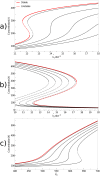A minimal model of burst-noise induced bistability
- PMID: 28448638
- PMCID: PMC5407650
- DOI: 10.1371/journal.pone.0176410
A minimal model of burst-noise induced bistability
Abstract
We investigate the influence of intrinsic noise on stable states of a one-dimensional dynamical system that shows in its deterministic version a saddle-node bifurcation between monostable and bistable behaviour. The system is a modified version of the Schlögl model, which is a chemical reaction system with only one type of molecule. The strength of the intrinsic noise is varied without changing the deterministic description by introducing bursts in the autocatalytic production step. We study the transitions between monostable and bistable behavior in this system by evaluating the number of maxima of the stationary probability distribution. We find that changing the size of bursts can destroy and even induce saddle-node bifurcations. This means that a bursty production of molecules can qualitatively change the dynamics of a chemical reaction system even when the deterministic description remains unchanged.
Conflict of interest statement
Figures






References
-
- Kendall D. Stochastic Processes and Population Growth. Journal of the Royal Statistical Society Series B-Statistical Methodology. 1949;11(2):230–264.
-
- Gillespie D. Exact Stochastic Simulation of Coupled Chemical-Reactions. Journal of Physical Chemistry. 1977;81(25):2340–2361. 10.1021/j100540a008 - DOI
-
- Nagel K, Schreckenberg M. A Cellular Automaton Model for Freeway Traffic. Journal De Physique I. 1992;2(12):2221–2229. 10.1051/jp1:1992277 - DOI
-
- Guckenheimer J, Holmes PJ. Nonlinear Oscillations, Dynamical Systems, and Bifurcations of Vector Fields. Springer; 2002.
-
- Horsthemke W. Noise Induced Transitions Vidal PDC, Pacault PDA, editors. Springer Series in Synergetics. Springer; Berlin Heidelberg; 1984.
MeSH terms
LinkOut - more resources
Full Text Sources
Other Literature Sources

